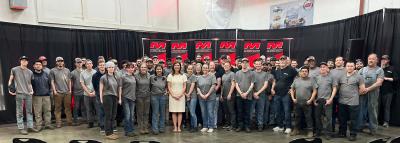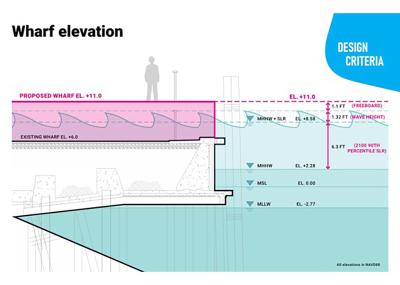For commuters getting in and out of Boston, this “Mega” Project will be like hitting “Mega” Bucks.
The second of five Massachusetts “Mega” Projects is under way as officials have broken ground on the new Fore River Bridge, a critical artery span connecting Weymouth and Quincy, two of the busiest suburbs south of Boston.
Ground was broken in front of the original 1936 bridge by Gov. Deval Patrick and a coterie of local and state officials on Nov. 12. Work will begin in earnest in January 2013. The project is expected to be completed in the fall of 2016.
A major part of Patrick’s Accelerated Bridge Program, the planned $244 million bridge will replace a 10-year “temporary” trestle that will parallel it as it is erected.
In the old days, government was deemed wasteful. In the new spirit of making every buck count, a new temporary trestle will serve two purposes — rerouting traffic and holding the heavy iron equipment to build the new bridge. In addition, many workers and craftsmen from the South Shore area will be hired to build the very bridge that will serve their hometowns.
Joint Venture
Under the direction of the Massachusetts Department of Transportation (MassDOT), J.F. White Co., Framingham, Mass., and Skanska-Koch of Carteret, N.J., have been selected to design and build the span as a joint venture.
“The White-Skanska Joint Venture is responsible for constructing the project and managing an array of subcontractors who are assisting them in the work,” said Michael Verseckes, spokesman of MassDOT. “Subcontractors include lead designer Parsons, Modjeski and Masters, the designers for the bridge’s operating machinery and controls; Gill Engineering, which will design the new bridge’s approach roadways; Haley and Aldritch for geotechnical engineering and design; Dan Brown and Associates, charged with the new bridge’s foundations, and Howard/Stein-Hudson, which supports the public involvement effort.”
Construction methods will be both horizontal and vertical, by road and by sea, making use of what is there and what must be brought up river.
“The project plans to make use of both conventional horizontal construction equipment that would be expected with a large bridge project, as well as specialized heavy lift equipment to move large steel segments, such as the bridge’s lifting span, into place,” added Verseckes. “As the job site is easily accessible by rail and water, the project team plans to make the best possible use of the river itself and the nearby railroad to bring in the large, permanent steel components associated with the new span. This will help minimize the number of large trucks traveling on Route 3A and reduce traffic impacts to the abutting communities of Quincy and Weymouth.”
Verseckes and local officials noted the long, noteworthy and recommended histories of the companies involved in this critical joint venture.
J.F. White
According to company literature, J.F. White was founded in 1914 by Joseph F. White Sr. During the 1920s and 1930s, J.F. White focused on roadwork and excavating foundations. In 1945, brothers Tom, Joe Jr., and John returned from World War II and reinvigorated the company. In 1950, J.F. White was awarded the contract to construct what is now known famously as Storrow Drive around Boston and Cambridge — one of the city’s most important roads paralleling the Charles River.
In the early 1970s, the company entered the arena as one of the region’s premier contractors with the award of the Charles River Dam project. The Charles River Dam transformed J.F. White from a road builder and excavating contractor into a competent and well-recognized heavy/civil contractor.
Larger and more challenging projects followed, including the Deer Island Wastewater Treatment Facility, the Ted Williams Tunnel and the North Street to New Chardon Street segment of the Central Artery/Tunnel (Big Dig) project. More recently, J.F. White has delivered the Interstate 93 Fast 14 project in Medford, Cedar Street project in Wellesley and the Chelsea Street Liftspan Bridge.
Skanska Koch
According to MassDOT, Skanska Koch has been involved with the construction or the rehabilitation of most major bridge structures in New York, and has performed bridge rehabilitation in other parts of the country. The company has more than 100 years of experience in steel erection, bridge construction and bridge rehabilitation.
Skanska Koch’s experience in the public-sector construction market has been exemplary and has earned the esteem and tremendous respect, not only of the public agencies that the company has served, but also of its vast array of competitors. Skanska Koch’s successful longstanding history with public-sector clients includes the New York City DOT; New York State; the Triborough Bridge & Tunnel Authority New York, New York; the Port Authority of New York & New Jersey (PANJNY); and Caltrans.
Up to 100 Workers Per Shift
The number of workers on the Fore River Bridge project will vary throughout the job depending on the current requirements of construction. The size of the force on the job site will vary from 10 to 100 depending on the phase of the project, according to Verseckes.
The project will be under construction year round.
“Certain aspects of the project, such as silt-producing in-water work, will be restricted due to the requirement to protect migrating anadromous fish that travel through the Fore River, but generally speaking, and with the exception of extreme weather events, some work will be under way on the project year round,” said Verseckes.
Workers on the project will generally work a double shift, with shifts currently scheduled for 7 a.m. to 10 p.m.
“At certain key moments during the project, such as concrete pours, and with the concurrence of MassDOT and adequate advance notice to the abutting communities, the job will operate on a 24-hour basis for a defined period of time,” added Verseckes of the consensus commitment to finish the massive project on-time and on-budget.
“Our Accelerated Bridge Program is a key part of our growth strategy of investing in education, innovation and infrastructure to create jobs and spur economic development,” said Patrick at the groundbreaking. “Investing in transportation infrastructure builds stronger communities for the next generation across the Commonwealth.”
Replacing a temporary bridge constructed in 2002, the new Fore River Bridge will be a vertical-lift bridge with several upgrades. The Fore River channel will be widened to accommodate the vessels that serve the active petroleum terminal, and its vertical clearance in the down position will be higher to reduce the number of openings for sailboats. Additionally, design improvements have been incorporated that will improve the aesthetics of the bridge.
One of the elected officials on hand at the groundbreaking had an interesting perspective. Mass. Congressman Stephen F. Lynch is a former iron worker in heavy construction before his life in politics. Lynch was glad that his local colleagues would get jobs on this huge project.
“I am pleased to see that construction will finally begin on the new Fore River Bridge,” Lynch said. “As an ironworker, I commend Governor Patrick and MassDOT Secretary [Richard] Davey for choosing a world-class construction team whose strong record of utilizing local South Shore building trades people will guarantee that the craftsmanship and pride of Weymouth and Quincy workers will become part of this bridge.”
MassDOT Secretary Davey added, “This project is an important link for South Shore drivers, but it also is an important corridor for the industrial shipping uses that need this bridge and this channel just as much. The finished product will not only meet those needs, but also will have major upgrades to accommodate pedestrians and cyclists as well.”
The new bridge will consist of two, 12 ft. (3.7 m) wide travel lanes on each side and a 5 ft. (1.5 m) bike lane on both sides; pedestrian sidewalks will be 6.5 ft. (2 m) wide on the bridge and expand to 9 ft. (2.7 )in width on the approaches to the bridge.
“The Fore River Bridge has long served as a vital link between the City of Quincy and the entire South Shore, and its viability is crucial to the continued economic success of the entire region,” said Senator John F. Keenan. “After many years of work, today’s ground breaking marks an important milestone in the bridge’s history and I look forward to working with MassDOT, state, city and town officials to make sure this replacement project is completed on-time, on-budget and with little interruption to local residents and commuters.”
Trestle Offers Support
According to the MassDOT Web site, the initial phase of construction after Christmas includes building a temporary trestle extending from both banks of the Fore River to the future location of the new bridge’s tower legs.
When finished, the temporary trestle will be used to support the very machinery that will drill the shafts for the new bridge’s foundations. It is currently expected that installation of these drilled shafts will begin in January 2013.
The steel supports and wooden deck for the temporary trestle will arrive at the work site on a fleet of trucks traveling up Route 3A, the artery carried over the Fore River Bridge. As the job progresses, and larger permanent bridge components begin arriving at the site, the project team expects to take advantage of deliveries by water and rail to help minimize traffic impacts.
Throughout construction, until the spring of 2016, at least one sidewalk will be available to pedestrians. During periods of reduced capacity on the temporary bridge, the community will be alerted through the MassDOT Web site and social media, the project email list, and other media channels.
MassDOT said construction phases will be as follows:
• Phase 1: Construction of the lifting span and towers, the north side dolphins and fenders (the system that protects the bridge from collisions with ships), four of the six approach spans and rehabilitation of the retaining walls. This phase runs from March 2013 to June 2015.
• Phase 2: Connection of the new bridge to the approaches, set for June to November 2015. This phase will include a reduction in capacity on the temporary bridge while the approach ramps are connected to the new structure. Also included in this segment of the job is testing of the machinery which lifts the movable span.
• Phase 3: All four lanes open and all traffic on the new bridge. Construction of the sidewalks, south side dolphins and fenders and removal of the old temporary bridge. Approximately Sept. 2015 to Sept. 2016.
The $3 billion Patrick-Murray Accelerated Bridge Program is greatly reducing the number of structurally deficient bridges in the state system, while creating thousands of construction jobs on bridge projects.
Since 2008, the number of former MassHighway and Dept. of Conservation and Recreation structurally deficient bridges has dropped from 543 to 437, a decline of 19.5 percent. As of Sept. 1, 2012, the ABP Program had completed 102 bridge projects, with another 67 bridge projects currently under construction and an additional 19 bridge projects scheduled to start construction within the next year.
Over the course of the eight-year program, more than 200 bridges are to be replaced or repaired, but none bigger than Fore River.
Today's top stories















